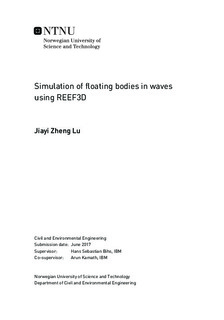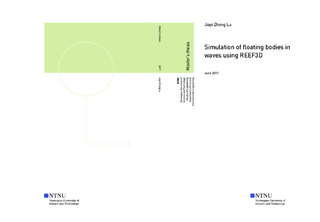| dc.description.abstract | The aim of this thesis is the validation of the 6 degrees of freedom (DOF) algorithm implemented in REEF3D for floating bodies. The 6DOF of a free-floating structure are three displacements in each axis and three rotations around each axis.
REEF3D is an open source Computational Fluid Dynamics (CFD) code developed in the Department of Civil and Environmental Engineering at NTNU. In the thesis, the numerical model used for the development of the simulations is explained as well as the main features and options of the software. Reynolds-Averaged Navier-Stokes (RANS) equations in three dimensions govern the numerical model. A fifth order WENO scheme is used to discretize the convection term in the RANS equations. Chorin s Projection Method is used to obtain the pressure term in the RANS equations. The Bi-Conjugate Gradient Stabilized method is used to solve the Poisson equation from the pressure model. The turbulence model adopted for the fluid is k-w. Second-order and third-order Total Variation Diminishing Runge-Kutta schemes are used for time treatment for momentums and the free surface, respectively. The numerical grid used is a Cartesian staggered grid with the ghost cell immersed boundary method. Simulations are carried out in a Numerical Wave Tank (NWT) composed of a wave generation zone, the wave tank and a numerical beach zone. The wave generation and numerical beach zones are explained in the numerical model. The turbulence near the solid boundaries or walls of the NWT is also considered with the wall law and no-slip condition for velocities. Wave theories used are Airy linear and second-order Stokes. The free surface is obtained with the level set method. The 6DOF algorithm used to obtain the forces, momentums and motions of the floating body is explained in detail.
Two cases are compared with experimental data found in the literature. Another case is performed as further study.
The first case is a two-dimensional simulation on a free-floating rectangular barge in non-linear waves using the second-order Stokes wave theory. The DOF are heave, pitch and surge. The motions are compared with experimental data. The undisturbed wave elevation is also compared. Different grid sizes are used to determine the differences between each grid result, stability and convergence to experimental results.
The second case is a three-dimensional simulation of the same floating body with the same wave conditions. Here, the effects of wall distance on the floating body motions is studied. Three tank widths with the same barge breadth are set to discern the effects of the gap between the floating body and the wall tank on the body motions. Results of motions and wave elevation are compared with the two-dimensional simulation and between the three-dimensional cases.
The validation case for three dimensions consists on a free-floating ship in linear waves. The ship is DTMB5512 which is a geosim of a US Navy s surface combatant. The ship geometry is imported with a function of REEF3D from a STL file. The DOF for the comparison with experimental data are heave and pitch. The undisturbed wave elevation is compared. The level set method definition of the geometry of the ship is discussed with different grid sizes. This analysis defines the choice of the grid size. Results of validation cases for two and three dimensions show favourable good agreement with experimental data. | |

